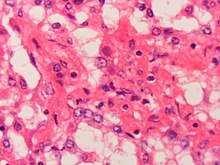Adenovirus infection is a contagious viral disease, caused by adenoviruses, commonly resulting in a respiratory tract infection.[1][10] Typical symptoms range from those of a common cold, such as nasal congestion, coryza and cough, to difficulty breathing as in pneumonia.[10] Other general symptoms include fever, fatigue, muscle aches, headache, abdominal pain and swollen neck glands.[2] Onset is usually two to fourteen days after exposure to the virus.[11] A mild eye infection may occur on its own, combined with a sore throat and fever, or as a more severe adenoviral keratoconjunctivitis with a painful red eye, intolerance to light and discharge.[5] Very young children may just have an earache.[2] Adenovirus infection can present as a gastroenteritis with vomiting, diarrhoea and abdominal pain, with or without respiratory symptoms.[5] However, some people have no symptoms.[4]
Adenovirus infection in humans are generally caused by Adenoviruses types B, C, E and F.[12] Spread occurs mainly when an infected person is in close contact with another person.[7] This may occur by either fecal–oral route, airborne transmission or small droplets containing the virus.[7] Less commonly, the virus may spread via contaminated surfaces.[7] Other respiratory complications include acute bronchitis, bronchiolitis and acute respiratory distress syndrome.[5] It may cause myocarditis, meningoencephalitis or hepatitis in people with weak immune systems.[5]
Diagnosis is by signs and symptoms, and a laboratory test is not usually required.[4] In some circumstances, a PCR test on blood or respiratory secretions may detect adenovirus DNA.[4][8] Other conditions that appear similar include whooping cough, influenza, parainfluenza, and respiratory syncytial virus.[2] Adenovirus gastroenteritis appears similar to diarrhoeal diseases caused by other infections.[13] Infection by adenovirus may be prevented by washing hands, avoiding touching own eyes, mouth and nose with unwashed hands, and avoiding being near sick people.[9] A live vaccine to protect against types 4 and 7 adenoviruses has been used successfully in some military personnel.[9] Management is generally symptomatic and supportive.[9] Most adenovirus infections get better without any treatment.[9] Medicines to ease pain and reduce fever can be bought over the counter.[9]
Adenovirus infections affect all ages.[3] They occur sporadically throughout the year, and outbreaks can occur particularly in winter and spring, when they may spread more quickly in closed populations such as in hospitals, nurseries, long-term care facilities, schools, and swimming pools.[11] Severe disease is rare in people who are otherwise healthy.[11] Adenovirus infection accounts for up to 10% of respiratory infections in children.[11] Most cases are mild and by the age of 10-years, most children have had at least one adenovirus infection.[5] 75% of conjunctivitis cases are due to adenovirus infection.[14] In 2016, the Global Burden of Disease Study estimated that globally, around 75 million episodes of diarrhea among children under the age of five-years, were attributable to adenovirus infection.[13] The first adenoviral strains were isolated in 1953 by Rowe et al.[15]
- ^ a b "Adenovirus Clinical Overview for Healthcare Professionals | CDC". www.cdc.gov. 29 November 2021. Retrieved 5 May 2022.
- ^ a b c d e f g Cite error: The named reference
Goldman2019was invoked but never defined (see the help page). - ^ a b c Cite error: The named reference
ATS2019was invoked but never defined (see the help page). - ^ a b c d e Cite error: The named reference
MSD2022was invoked but never defined (see the help page). - ^ a b c d e f g h i j k l Shieh, Wun-Ju (10 September 2021). "Human adenovirus infections in pediatric population - An update on clinico-pathologic correlation". Biomedical Journal. 45 (1): S2319–4170(21)00109–8. doi:10.1016/j.bj.2021.08.009. ISSN 2320-2890. PMC 9133246. PMID 34506970. S2CID 237479412.
- ^ a b Cite error: The named reference
CDCsymptomswas invoked but never defined (see the help page). - ^ a b c d "Adenovirus: transmission". www.cdc.gov. 29 November 2021. Retrieved 7 May 2022.
- ^ a b Cite error: The named reference
Arnold2021was invoked but never defined (see the help page). - ^ a b c d e f g h "Adenovirus: preventing and treating Adenovirus". www.cdc.gov. 29 November 2021. Retrieved 7 May 2022.
- ^ a b "Adenovirus". www.cdc.gov. 16 March 2021. Retrieved 23 April 2022.
- ^ a b c d Cite error: The named reference
Lynch2016was invoked but never defined (see the help page). - ^ Flint, S. Jane; Nemerow, Glen R. (2017). "8. Pathogenesis". Human Adenoviruses: From Villains To Vectors. Singapore: World Scientific. pp. 153–183. ISBN 978-981-310-979-7.
- ^ a b Cite error: The named reference
Lee2020was invoked but never defined (see the help page). - ^ Cite error: The named reference
Labib2020was invoked but never defined (see the help page). - ^ Haveman, Lianne M.; Bierings, Marc; Wolf, Tom F.W. (2004). "12. Adenovirus". In Kimpen, Jan L. L.; Ramilo, Octavio (eds.). The Microbe-Host Interface in Respiratory Tract Infections. Norfolk: CRC Press. p. 271. ISBN 0-8493-3646-5.
